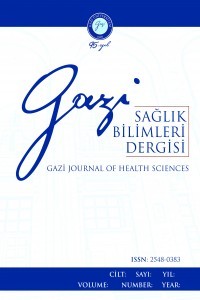Medial Kompartman Gonartrozunda Oxford Faz 3 Unikompartmantal Protezin Erken ve Orta Dönem Klinik ve Radyolojik Sonuçları
Gonartroz, anteromedial osteoartrit, unikondiler diz artroplastisi
Early and Mid-term Clinical and Radiological Results of Oxford Phase 3 Unicompartmental Prosthesis in Medial Compartment Gonarthrosis
___
- REFERANSLAR
- 1.Pandit H, Jenkins C, Barker K, Dodd CAF, Murray DW. The Oxford medial unicompartmental knee replacement using a minimally invasive approach. J Bone Joint Surg (Br) 2006; 88-B: 54-60
- 2.Goodfellow JW.O’Connor JJ, Dood C, Murray D. Unicompartmental arthroplasty with the oxford knee 2006
- 3.Goodfellow JW, Kershaw CJ, Benson MK, O’Connor JJ. The Oxford Knee for unicompartmental osteoarthritis. The first 103 cases. J Bone Joint Surg Br. 1988; 70:692-701.
- 4.Dennis D, Komistek R, Scuderi G. In vivo three-dimensional determination of kinematics for subjects with a normal knee or a unicompartmental or total knee replacement. J Bone Joint Surg Am. 2001; 83(suppl 2 pt 2):104-115.
- 5.Laskin RS. Unicompartmental knee replacement: some unanswered questions. Clin Orthop. 2001; 392:267-271.
- 6.Svard UC, Price AJ. Oxford medial unicompartmental knee arthroplasty. A survival analysis of an independent series. J Bone Joint Surg Br. 2001; 83:191-194.
- 7.Argenson JN, Chevrol-Benkeddache Y, Aubaniac JM. Modern unicompartmental knee arthroplasty with cement: a three to ten-year follow-up study. J Bone Joint Surg Am. 2003; 84:2235-2239.
- 8.Murray, D.W. et al. The Oxford medial unicompartmental arthroplasty, a ten year survival study. Journal of Bone and Joint Surgery [Br].1998; 80-B:983– 89.
- 9.Svard UC, Price AJ. Oxford medial unicompartmental knee arthroplasty. A survival analysis of an independent series. J Bone Joint Surg Br. 2001; 83:191-194.
- 10.Rajasekhar, C., Das,S., and Smith,A.Unicompartmental knee arthroplasty.2- to12-year results in a community hospital.J.Bone Jt Surg.,2004,86B(7),983- 985
- 11. Keys,G.W.,Ul-Abiddin,Z.,and Toh,E.M.Analysis of first fourty Oxford medial unicompartmental knee replacements from a small district hospital in UK.The Knee,2004,11(5),375-377.
- 12. Weale AE, Murray DW, Crawford R, Psychoyios V, Bonomo A, Howell G, O'ConnorJ, Goodfellow JW. Does arthritis progress in the retained compartments after 'Oxford' medial unicompartmental arthroplasty? A clinical and radiological study with a minimum ten-year folIowup.J Bone Joint Surg Br 1999; 81-B: 783-9.
- 13. Berger RAH, Meneghini RMH, HSheinkop MBH, HDella Valle CJH, H Jacobs JJH, HRosenberg AGH,Galante JOH. The progression of patellofemoral arthrosis after medial unicompartmental replacement: results at 11 to 15 years. Clin Orthop 2004;428:92-99.
- 14. Pandit H.,Jenkins C.,Gill H.S.,Barker K.,Dodd C.A.F.,Murray D.W.Minimally invasive Oxford Phase 3 unikompartmental knee replacement.J Bone Joint Surg(Br) 2011;93-B:198-204
- 15. Pandit H, Jenkins C, Beard D, Dodd C, Murray D. Oxford unicompartmental kneearthroplasty using a minimally invasive surgical technique: a five-year survival study. Paper presented at: Biennial Congress meeting of the International Society of Arthroscopy Knee Surgery and Orthopaedic Sports Medicine; April 2005; Hollywood, Fla.
- 16. Herniqou P,Deschamps G.Alignment influences wear in the knee after medial unicompartmental arthroplasty.Clin Orthop 2004;423: 161-5
- 17. Tabor OB Jr, Tabor OB, Bernard M,Wan JY.Unicompartmental knee arthroplasty:long-term success in middle-age and obese patients.J Surg Orthop Adv 2005;14:59-63
- 18. Murray, D.W. et al. The Oxford medial unicompartmental arthroplasty, a ten year survival study. Journal of Bone and Joint Surgery [Br].1998; 80-B:983– 89.
- 19. Svard UC, Price AJ.Oxford medial unicompartmental knee arthroplasty. A survival analysis of an independent series. J Bone Joınt Surg (br) 2001;83- B191-4
- 20. Price A.J, Dodd CAF, Svard UGC, Murray DW.Oxford uicompartmental arthroplasty in patients younger than 60 years of age.J Bone Joınt Surg (Br)2005;87-B1488-92
- 21. Argenson JN, O’Connor JJ.Polyethylene wear in meniscal knee replacement.A one to nine-year retrieval analysis of the Oxford knee.J Bone Joint Surg(Br)1992;74-B:228-32
- 22. Lewold S, Goodman S, Knutson K, Robertsson O, Lidgren L. Oxford meniscal bearing knee versus the Marmor knee in unicompartmental arthroplasty for arthrosis. A Swedish multicenter survival study. J Arthroplasty 1995; 10: 722-31.
- ISSN: 2548-0383
- Yayın Aralığı: Yılda 3 Sayı
- Başlangıç: 2015
- Yayıncı: Gazi Üniversitesi
HEMŞİRELERİN İŞYERİ ŞİDDETİNE MARUZ KALMA DURUMLARI İLE İŞ DOYUMLARI VE İŞTEN AYRILMA EĞİLİMLERİ
Nigar ÜNLÜSOY DİNÇER, Refia Selma GÖRGÜLÜ, Aslıhan BOYACIOĞLU
ADÖLESANLARDA KRONOTİPE GÖRE ÖĞÜN ZAMANI VE BESİN TERCİHLERİNİN İNCELENMESİ
Sağlıklı Genç Yetişkinlerde Akıllı Telefon Bağımlılığının Parmak Duyusu Hassasiyetine Etkisi
Multiple Sklerozlu Hastalarda El Mental Rotasyon Görevi
Büsra CANDİRİ, Engin RAMAZANOĞLU, Burcu TALU, Mehmet TECELLİOĞLU
Doğaç KARAGÜVEN, İlker ÇETİN, Alper KAYA, Berk GÜÇLÜ, Burak AKAN
Persistent Postural Perceptual Dizziness Tedavisinde Vestibüler Rehabilitasyonun Etkisi
Besin Ambalajlarında Sürdürülebilirliğe İlişkin Logo Varlığının İncelenmesi: İtalya Örneği
Gebe Kadınların Sağlık Uygulamaları Ve Etkileyen Faktörlerin İncelenmesi
